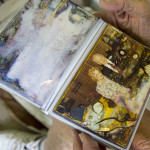RALEIGH, N.C. – If you’re a Hurricane Matthew survivor in North Carolina who registered with FEMA and you’ve been referred to the U.S. Small Business Administration for a low-interest disaster loan, you should complete and return the loan application as soon as possible.
Obtaining a low-interest disaster loan may be the solution to your recovery needs by providing you the necessary funds for home repair, rebuilding and property loss. Returning the completed application also may enable you to qualify for FEMA disaster recovery grants that do not have to be repaid.
If you are a homeowner or renter and SBA determines you cannot afford a loan, you may be considered for FEMA’s other needs assistance program, which provides grants for disaster-related medical and dental care, funeral costs and vehicle repairs. You also may be eligible for assistance from other organizations, too.
There is no requirement to take out a loan if one is offered from SBA. If you are approved for a disaster loan, you have the option not to accept the loan.
Next to insurance, SBA is the primary source of funds for real estate property repairs and replacing lost contents following a disaster. Renters and homeowners alike may borrow up to $40,000 to repair or replace clothing, furniture, cars or appliances damaged or destroyed in the disaster. Homeowners may be eligible for low-interest loans up to $200,000 for primary residence structural repairs or rebuilding.
There are important reasons for you to file the loan application (even if you don’t think you currently need a loan):
- Your insurance settlement may fall short. As you began to recover from the effects of your personal disaster, you may discover that you were underinsured for the amount of work required to repair or replace your home. An SBA low-interest disaster loan can cover the gap.
- SBA will work with you to provide a loan that fits your personal budget. If you already have a mortgage on damaged property, SBA specialists can help with a low-interest loan you can afford.
SBA loans have low interest rates
Interest rates for loans for homeowners and renters can be as low as 1.563 percent.
Refinancing and relocation loans may be available on a case-by-case basis. Survivors are encouraged to speak with an SBA representative for details.
For more information, call the SBA at 800-659-2955 (800-877-8339 TTY). Homeowners, renters and businesses may visit SBA’s secure website https://disasterloan.sba.gov/ela/ to apply online for disaster loans.
Register with FEMA for help or information regarding disaster assistance:
- Online at DisasterAssistance.gov.
- Call the FEMA Helpline at 800-621-3362 for voice, 711 and Video Relay Service (VRS). If you are deaf, hard of hearing or have a speech disability and use a TTY, call 800-462-7585.
- Download the FEMA Mobile App and apply.
If you’re a business owner, you may be able to borrow up to $2 million from the SBA for physical damage and economic injury.
The easiest way to apply for an SBA low-interest disaster loan is to visit a FEMA/State Disaster Recovery Center (DRC) or an SBA Business Recovery Center (BRC) and meet with an SBA representative in person. SBA has staff at all DRCs and BRCs to help you with your application. To find the closest DRC go online to fema.gov/drc or ncdps.gov/.
BRCs are listed below.
- Business Recovery Center #1 (Cumberland County)
SBTDC at Fayetteville State University
Small Business and Economics Building, BRC
1200 Murchison Road, Suite 306, Rooms A and D
Fayetteville, NC 28301
- Business Recovery Center #2 (Pitt County)
SBTDC Regional Service Center, East Carolina University
Willis Building, BRC
300 E. 1st Street
Greenville, NC 27858-1201
- Business Recovery Center #3 (Robeson County)
- Robeson Community College Workforce Development Center
Building 18
5160 Fayetteville Road
Lumberton, NC 28358
For more information on SBA disaster loans, visit sba.gov/disaster.
For more information on the North Carolina recovery, visit fema.gov/disaster/4285 and readync.org. Follow FEMA on Twitter @femaregion4 and North Carolina Emergency Management @ncemergency.
###
Disaster recovery assistance is available without regard to race, color, religion, nationality, sex, age, disability, English proficiency or economic status. If you or someone you know has been discriminated against, call FEMA toll-free at 800-621-3362 or TTY at 800-462-7585.
FEMA’s mission is to support our citizens and first responders to ensure that as a nation we work together to build, sustain, and improve our capability to prepare for, protect against, respond to, recover from, and mitigate all hazards. Follow FEMA on twitter at @femaregion4. Download the FEMA app with tools and tips to keep you safe before, during, and after disasters.
Dial 2-1-1 or 888-892-1162 to speak with a trained call specialist about questions you have regarding Hurricane Matthew; the service is free, confidential and available in any language. They can help direct you to resources. Call 5-1-1 or 877-511-4662 for the latest road conditions or check the ReadyNC mobile app, which also has real-time shelter and evacuation information. For updates on Hurricane Matthew impacts and relief efforts, go to ReadyNC.org or follow N.C. Emergency Management on Twitter and Facebook. People or organizations that want to help ensure North Carolina recovers can visit NCdisasterrelief.org or text NCRecovers to 30306.
The U.S. Small Business Administration (SBA) is the federal government’s primary source of money for the long-term rebuilding of disaster-damaged private property. SBA helps homeowners, renters, businesses of all sizes, and private non-profit organizations fund repairs or rebuilding efforts and cover the cost of replacing lost or disaster-damaged personal property. These disaster loans cover losses not fully compensated by insurance or other recoveries and do not duplicate benefits of other agencies or organizations. For more information, applicants may contact SBA’s Customer Service Center by calling (800) 659-2955, emailing disastercustomerservice@sba.gov, or visiting SBA’s Web site at www.sba.gov/disaster. Deaf and hard-of-hearing individuals may call (800) 877-8339.






